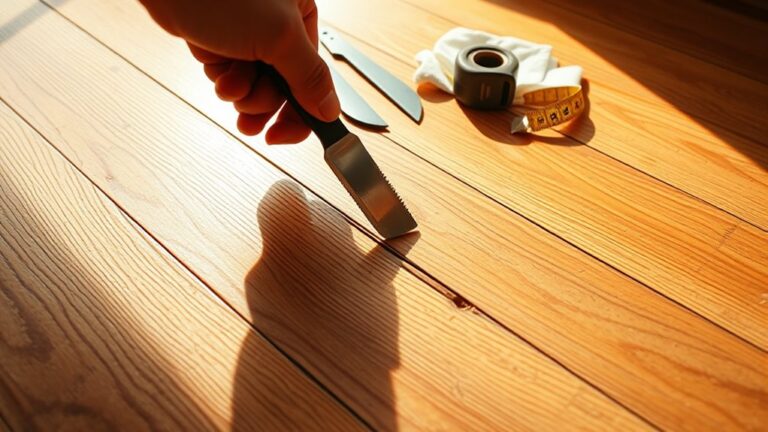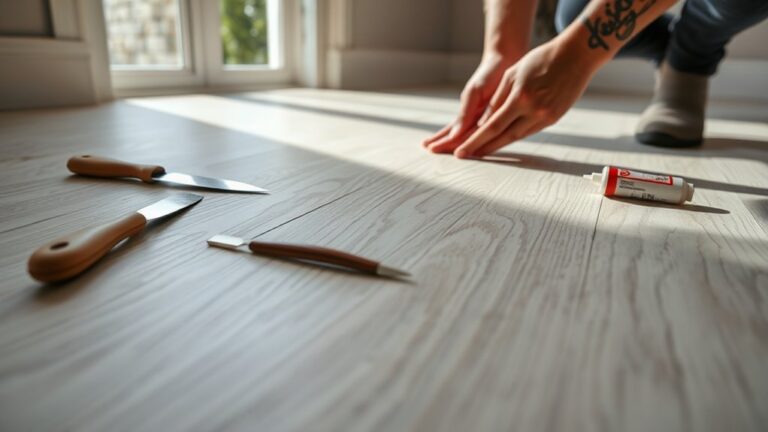To get paint off hardwood floors, first identify the paint type and its age to choose the right method. Then, gather tools like a plastic scraper, cloths, and a suitable remover—mild for latex or stronger for oil-based paint. Gently scrape excess paint without damaging wood, apply the remover carefully, and clean the area thoroughly. Finally, dry the surface and restore its finish. Follow these steps, and you’ll be set for a deeper understanding of each phase.
Assess the Type and Age of the Paint

Before you begin removing paint from your hardwood floors, you need to determine both the type and age of the paint. Identifying paint types—whether latex, oil-based, or enamel—affects the removal method you’ll choose. Latex paint, usually water-based, is easier to soften and scrape, while oil-based paint requires stronger solvents. Also, consider the floor conditions; older, worn hardwood may be more sensitive to harsh chemicals or aggressive scraping. Fresh paint is simpler to remove with minimal damage risk, but older, cured paint often bonds tightly to the wood, demanding careful treatment to avoid surface damage. Evaluating these factors precisely guarantees you select an effective, safe approach, preserving your floor’s integrity and your freedom to restore it without unnecessary complications.
Gather Necessary Tools and Materials
To effectively remove paint from your hardwood floors, you’ll need a specific set of tools and materials tailored to the paint type and floor condition. Start by identifying whether you’re dealing with water-based or oil-based paint, as this affects your choice of remover—water and mild soap suffice for latex paint, while oil-based paints require stronger solvents. Gather a plastic scraper, soft cloths, a bucket of warm water, and paint remover suitable for the paint type. Don’t forget floor protection: use drop cloths or plastic sheeting to shield unaffected areas from spills or drips. Gloves and safety goggles guarantee your safety during removal. By assembling the right tools and protecting your floor, you set the stage for an efficient, damage-free paint removal process.
Gently Scrape Off Excess Paint

With your tools ready and the appropriate remover selected, you can start tackling the paint on your hardwood floors. Begin by gently scraping off excess paint to avoid damaging the wood surface. Use a plastic scraper or putty knife, applying light pressure and working at a shallow angle. Different paint types require specific scraping techniques to maximize effectiveness without harm.
| Paint Type | Recommended Scraper | Scraping Technique |
|---|---|---|
| Latex Paint | Plastic Scraper | Gentle, shallow angle |
| Oil-Based Paint | Metal Putty Knife | Careful, avoid gouging |
| Water-Based Paint | Plastic or Metal Scraper | Light pressure, frequent checks |
Apply a Suitable Paint Remover or Cleaner
Select a paint remover or cleaner that matches the type of paint and finish on your hardwood floors. Water-based paints require milder solutions, while oil-based paints may need stronger solvents. Look for paint remover brands known for safety and effectiveness, especially those offering environmentally friendly options to protect your indoor air quality and the floor’s finish. Test a small, hidden area first to verify the remover won’t damage the wood. Apply the product according to the instructions, using a soft cloth or sponge, and avoid excessive soaking. Work methodically, allowing the remover to soften the paint without harming the floor. By choosing the right product and applying it carefully, you maintain control over the process and preserve the natural freedom of your hardwood Bodenbelag.
Clean and Restore the Hardwood Surface

Begin by gently wiping the area with a damp cloth to remove any loosened paint residue and cleaning solution. Once clean, dry the surface thoroughly to prevent moisture damage. To maintain your hardwood’s integrity and prolong its life, focus on hardwood maintenance by restoring its finish and guaranteeing surface protection. Here’s what you should do next:
- Lightly sand any rough patches with fine-grit sandpaper to smooth the surface.
- Apply a hardwood floor cleaner or polish to revive the wood’s natural shine.
- Use a protective sealant or wax to shield the floor from future stains and wear.
- Avoid harsh chemicals that can degrade the finish or wood fibers.
Following these steps guarantees your hardwood floor stays beautiful and durable, giving you the freedom to enjoy your space without worry.




